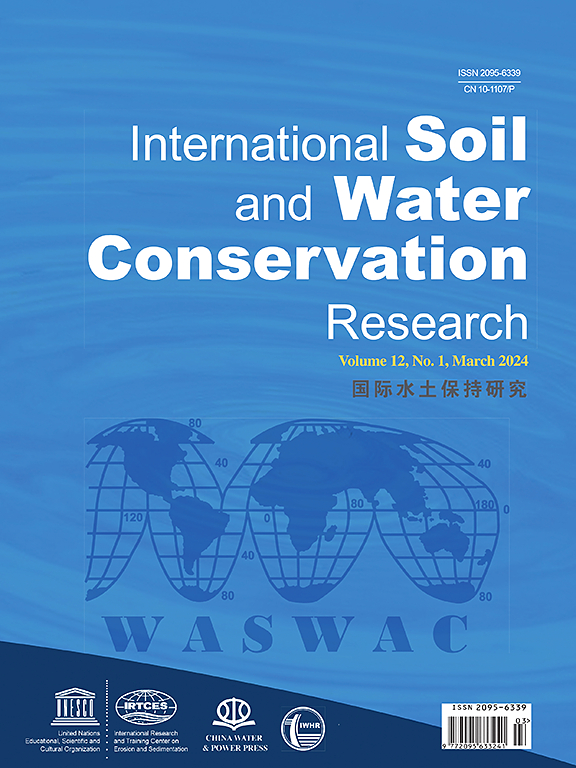基于遥感数据的国家尺度5和10 cm深度土壤平均温度的年内特征
IF 7.3
1区 农林科学
Q1 ENVIRONMENTAL SCIENCES
International Soil and Water Conservation Research
Pub Date : 2025-06-11
DOI:10.1016/j.iswcr.2025.06.001
引用次数: 0
摘要
土壤温度(ST)是影响土壤所有过程的重要物理性质;它是气候系统的一个相关组成部分,影响陆地生态、水文和生物地球化学过程。本文介绍了利用地表温度(LST)、归一化植被指数(NDVI)和日太阳赤纬(Ds),结合气象站数据,对5cm (SMTc5cm)和10cm (SMTc10cm)深度被覆土壤温度进行模型定标的方法。使用MODIS图像衍生的18个LST和10个NDVI处理组合进行迭代,目的是选择和应用经过验证的模型来表征乌拉圭各地的SMTc5cm和SMTc10cm的年内特征。结果表明,SMTc5cm和SMTc10cm模型的R2值分别为0.84和0.87 ~ 0.89,SMTc5cm和SMTc10cm模型的RMSE值分别为2.3°C和2.1 ~ 1.8°C。与SMTc5cm和SMTc10cm的观测值,以及SMTc5cm与20 cm深度和未覆盖土壤的ST的观测值对比表明,模型准确预测了土壤温度并保持了相移,剖面相交时间变化较小。使用白天和夜间LST观测的平均值以及过滤后的NDVI序列的模型比使用原始数据的模型获得了更好的拟合。初步观察结果强调了进一步研究森林、土壤成分和地下特征对土壤温度的影响的重要性。本文章由计算机程序翻译,如有差异,请以英文原文为准。
Intra-annual characterization of soil mean temperature at 5 and 10 cm depths based on remote sensing data, at country scale
Soil temperature (ST) is an important physical property that influences all soil processes; it is a relevant component of the climate system and impacts terrestrial ecological, hydrological and biogeochemical processes. Its variability presents challenges, limiting studies the spatiotemporal distribution and prediction of ST. This study describes the calibration of a model that uses land surface temperature (LST), the Normalized Difference Vegetation Index (NDVI), and daily solar declination (Ds), along with data from meteorological stations, to predict the covered soil temperature at depth of 5 cm (SMTc5cm) and 10 cm (SMTc10cm). Iterations were performed using combinations of 18 LST and 10 NDVI treatments derived from MODIS images, with the aim of selecting and applying validated models for the intra-annual characterization of SMTc5cm and SMTc10cm across Uruguay. The Results showed that the models for SMTc5cm and SMTc10cm had R2 values of 0.84 and 0.87-0.89, respectively, and RMSE values of 2.3 °C for SMTc5cm and 2.1-1.8 °C for SMTc10cm. Comparisons with observed SMTc5cm and SMTc10cm, and SMTc5cm with observed ST at 20 cm depth and uncovered soil, indicated that the models accurately predicted soil temperature and maintained phase shifts, with minor variations in the timing of profile intersections. Models that used averages of daytime and nighttime LST observations, along with filtered NDVI series, achieved better fits than those using the original data. Preliminary observations highlight the importance of further investigating the effects of forests, soil composition, and subsurface characteristics on soil temperature.
求助全文
通过发布文献求助,成功后即可免费获取论文全文。
去求助
来源期刊

International Soil and Water Conservation Research
Agricultural and Biological Sciences-Agronomy and Crop Science
CiteScore
12.00
自引率
3.10%
发文量
171
审稿时长
49 days
期刊介绍:
The International Soil and Water Conservation Research (ISWCR), the official journal of World Association of Soil and Water Conservation (WASWAC) http://www.waswac.org, is a multidisciplinary journal of soil and water conservation research, practice, policy, and perspectives. It aims to disseminate new knowledge and promote the practice of soil and water conservation.
The scope of International Soil and Water Conservation Research includes research, strategies, and technologies for prediction, prevention, and protection of soil and water resources. It deals with identification, characterization, and modeling; dynamic monitoring and evaluation; assessment and management of conservation practice and creation and implementation of quality standards.
Examples of appropriate topical areas include (but are not limited to):
• Conservation models, tools, and technologies
• Conservation agricultural
• Soil health resources, indicators, assessment, and management
• Land degradation
• Sustainable development
• Soil erosion and its control
• Soil erosion processes
• Water resources assessment and management
• Watershed management
• Soil erosion models
• Literature review on topics related soil and water conservation research
 求助内容:
求助内容: 应助结果提醒方式:
应助结果提醒方式:


